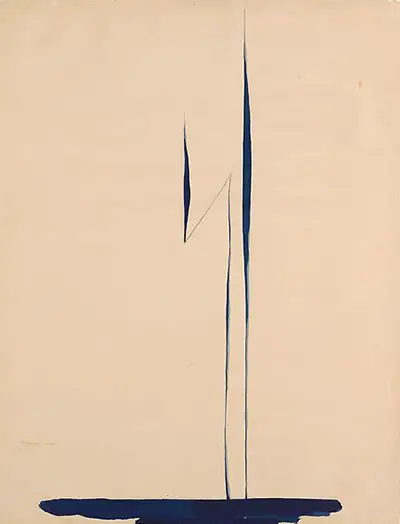Blue Lines X shows us an artist who is in transition. O'Keeffe is moving away from the more traditional art studies that she went through as a student, and is now attempting to forge her own path. Initially it would be her drawings that alerted others as to her natural abilities, but her technical brilliance was only married with innovation later on once she started to experiment with different ideas. During the 1910s, which is when this artwork was completed, she was still very much in the early stage of pushing towards her own unique approach and was just starting to build her confidence as an artist. Watercolours would also feature from time to time within this decade and actually marked her first use of brighter tones, although that is not displayed here within Blue Lines X. Several landscape paintings were created using simple bands of bright watercolour and this gave us a eye into the future.
This appropriately named artwork features several slim blue lines which reach up towards the tip of the paper. There are points at which they thicken in width, whilst at the very bottom is a flood of paint, something akin to some spilled oil. This is the artist at her expressive best, though few would have been accepting of this minimalist approach during such an early point in the 20th century. It was only later that true acceptance arrived across the mainstream and this was achieved through hard work by a large number of different artists, both in the US and also Europe. What is demonstrated here are the early shoots of growth which would eventually spread and grow across the western world to help us arrive at the point at which we are today.
The Metropolitan Museum of Art in New York places host to this memorable abstract drawing by O'Keeffe from 1916. Visitors to this fabulous art institution will find one of the most extensive and high quality collections anywhere in the world, which helps it to continually rank amongst the most visited art venues in the world. Washington Crossing the Delaware by Emanuel Leutze is perhaps one of their highest profile objects, though others to look out for include the likes of Melencolia I by Albrecht Dürer, plus also a large number of items from the careers of other great masters such as Rembrandt, Van Dyck and Degas. Aside from all of this, sculpture is also particularly well served, with both classical and more modern styles covered in great detail around the extensive grounds. It remains a true gem in the crown of the American cultural offering and one of the must-see attractions found in New York, USA.
